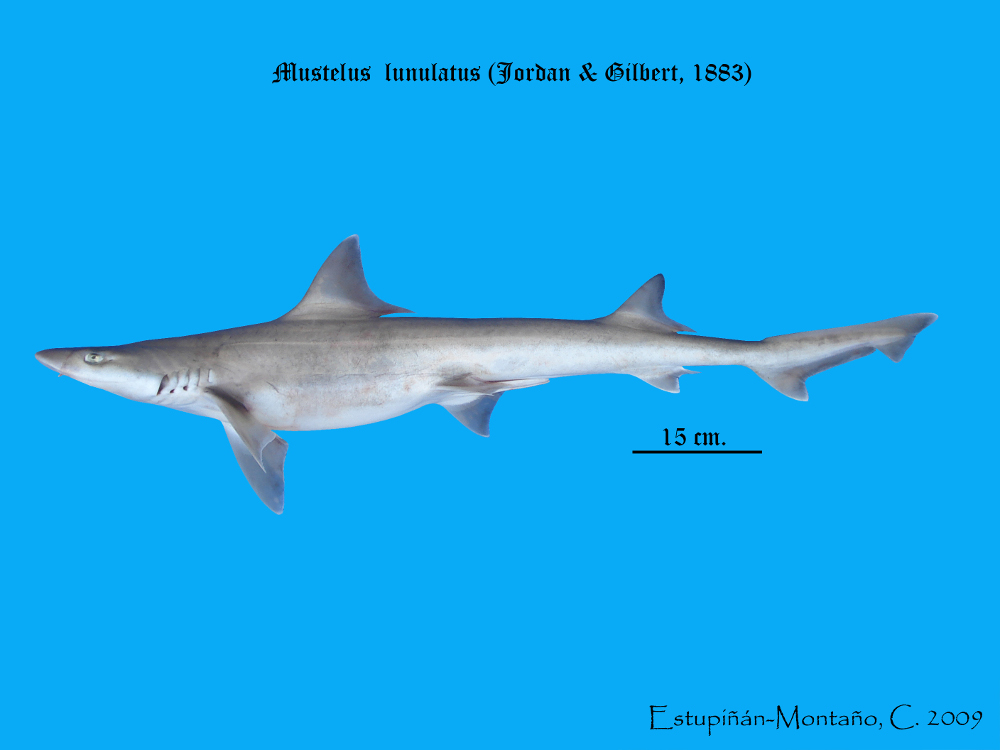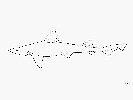Mustelus lunulatus
Jordan & Gilbert, 1882
Sicklefin smooth-hound
Classification: Elasmobranchii Carcharhiniformes Triakidae
Reference of the original description
Description of four new species of sharks, from Mazatlan, Mexico. Proceedings of the United States National Museum, 5, 102–110
Description of four new species of sharks, from Mazatlan, Mexico. Proceedings of the United States National Museum, 5, 102–110
Image of the original description
No image in first description.
No image in first description.
Synonyms / new combinations and misspellings
Cynias lunulatus, Galeorhinus lunulatus, Galeus lunulatus, Mustelus aff. lunulatus, Mustelus cf. lunulatus
Cynias lunulatus, Galeorhinus lunulatus, Galeus lunulatus, Mustelus aff. lunulatus, Mustelus cf. lunulatus
Description :
Citation: Mustelus lunulatus Jordan & Gilbert, 1882: In: Database of modern sharks, rays and chimaeras, www.shark-references.com, World Wide Web electronic publication, Version 12/2025
Please send your images of "Mustelus lunulatus" to info@shark-references.com

Mustelus lunulatus Jordan & Gilbert, 1882, (viejitas o mamonas) Ecuador © Colombo Estupiñán-Montaño, Centro Interdisciplinario de Ciencias Marinas - CICIMAR

Mustelus lunulatus Jordan & Gilbert, 1882, (viejitas o mamonas) Ecuador © Colombo Estupiñán-Montaño, Centro Interdisciplinario de Ciencias Marinas - CICIMAR
Common names
 Cazón,
Cazón,  Cazón segador,
Cazón segador,  Musola segadora,
Musola segadora,  Tollo,
Tollo,  Tollo mamon,
Tollo mamon,  Vieja,
Vieja,  Emissole mamon,
Emissole mamon,  Sicklefin smooth hound,
Sicklefin smooth hound,  Sicklefin smooth-hound,
Sicklefin smooth-hound,  Sicklefin smoothhound
Sicklefin smoothhound
 Cazón,
Cazón,  Cazón segador,
Cazón segador,  Musola segadora,
Musola segadora,  Tollo,
Tollo,  Tollo mamon,
Tollo mamon,  Vieja,
Vieja,  Emissole mamon,
Emissole mamon,  Sicklefin smooth hound,
Sicklefin smooth hound,  Sicklefin smooth-hound,
Sicklefin smooth-hound,  Sicklefin smoothhound
Sicklefin smoothhound
Short Description
Diagnosis after Compagno, 1984 [517]: Body fairly slender. Head short, prepectoral length 19 to 21% of total length; snout moderately long and bluntly angular in lateral view, preoral snout 5.6 to 6.7% of total length, preorbital snout 6.3 to 8.1% of total length; internarial space broad, 2.3 to 3.3% of total length; eyes fairly large, eye length 2.9 to 3.7 times in preorbital snout and 2.2 to 3% of total length; interorbital space fairly broad, 4.3 to 4.9% of total length; mouth very long, greater than eye length and 3.4 to 3.9% of total length; upper labial furrows shorter than lowers, upper furrows 0.8 to 1.2% of total length; teeth molariform and asymmetric, with cusp reduced to a low point, cusplets absent except in very young sharks; condition of buccopharyngeal denticles unknown. Interdorsal space 18 to 22% of total length; trailing edges of dorsal fins denticulate, without bare ceratotrichia; first dorsal falcate with posterior margin vertical from apex, midbase closer to pectoral bases than to pelvics; pectoral fins fairly small, length of anterior margins 13 to 16% of total length, width of posterior margin 10 to 13% of total length; pelvic fins moderate-sized,. anterior margin length 7.4 to 9.1% of total length; anal height 3.1 to 3.9% of total length; anal-caudal space greater than second dorsal height, 5.9 to 7.4% of total length; ventral caudal lobe strongly falcate in adults. Crowns of lateral trunk denticles lanceolate, with longitudinal ridges extending about 2/3 of crown length. Skeleton not hypercalcified in adults; palatoquadrates not subdivided; monospondylous precaudal centra 28 to 34, diplospondylous precaudal centra 43 to 51, precaudal centra 74 to 82. Colour uniform grey or grey-brown, above, light below, without white or dark spots or dark bars. Development uncertain. Size large, adults 70 to 110+ cm.
Diagnosis after Compagno, 1984 [517]: Body fairly slender. Head short, prepectoral length 19 to 21% of total length; snout moderately long and bluntly angular in lateral view, preoral snout 5.6 to 6.7% of total length, preorbital snout 6.3 to 8.1% of total length; internarial space broad, 2.3 to 3.3% of total length; eyes fairly large, eye length 2.9 to 3.7 times in preorbital snout and 2.2 to 3% of total length; interorbital space fairly broad, 4.3 to 4.9% of total length; mouth very long, greater than eye length and 3.4 to 3.9% of total length; upper labial furrows shorter than lowers, upper furrows 0.8 to 1.2% of total length; teeth molariform and asymmetric, with cusp reduced to a low point, cusplets absent except in very young sharks; condition of buccopharyngeal denticles unknown. Interdorsal space 18 to 22% of total length; trailing edges of dorsal fins denticulate, without bare ceratotrichia; first dorsal falcate with posterior margin vertical from apex, midbase closer to pectoral bases than to pelvics; pectoral fins fairly small, length of anterior margins 13 to 16% of total length, width of posterior margin 10 to 13% of total length; pelvic fins moderate-sized,. anterior margin length 7.4 to 9.1% of total length; anal height 3.1 to 3.9% of total length; anal-caudal space greater than second dorsal height, 5.9 to 7.4% of total length; ventral caudal lobe strongly falcate in adults. Crowns of lateral trunk denticles lanceolate, with longitudinal ridges extending about 2/3 of crown length. Skeleton not hypercalcified in adults; palatoquadrates not subdivided; monospondylous precaudal centra 28 to 34, diplospondylous precaudal centra 43 to 51, precaudal centra 74 to 82. Colour uniform grey or grey-brown, above, light below, without white or dark spots or dark bars. Development uncertain. Size large, adults 70 to 110+ cm.
Human uses
fisheries: commercial
fisheries: commercial
Biology
Ovoviviparous, embryos feed solely on yolk [733]. Distinct pairing with embrace [17086].
Diet: off El Pardito Island, Baja California Sur, Mexico (data base: 40 stomachs were obtained, all containing food): The diet included 21 food components; fish and crustaceans were the most representative taxonomic groups, making up 97% of the M. lunulatus diet. A cephalopod, which made a minimal input to the diet, was also recorded. By number as well as by weight, the most important prey were Munida tenella, Cancer amphioetus and Hemisquilla ensigera californiensis. The remaining food components had values under 8%. The most frequent prey items in the stomachs were M. tenella, Decapterus spp., H. ensigera californiensis and C. amphioetus [17032].
central coast of the Colombian Pacific [25131]: (data basis: 116, 15 had empty stomach, TL 45-112 cm); Diet: Brachyura (95.05% percent by frequency of occurrence=FO), Stomatopoda (56.44%FO), Dendrobranchiata (23.76%FO)
Ovoviviparous, embryos feed solely on yolk [733]. Distinct pairing with embrace [17086].
Diet: off El Pardito Island, Baja California Sur, Mexico (data base: 40 stomachs were obtained, all containing food): The diet included 21 food components; fish and crustaceans were the most representative taxonomic groups, making up 97% of the M. lunulatus diet. A cephalopod, which made a minimal input to the diet, was also recorded. By number as well as by weight, the most important prey were Munida tenella, Cancer amphioetus and Hemisquilla ensigera californiensis. The remaining food components had values under 8%. The most frequent prey items in the stomachs were M. tenella, Decapterus spp., H. ensigera californiensis and C. amphioetus [17032].
central coast of the Colombian Pacific [25131]: (data basis: 116, 15 had empty stomach, TL 45-112 cm); Diet: Brachyura (95.05% percent by frequency of occurrence=FO), Stomatopoda (56.44%FO), Dendrobranchiata (23.76%FO)
Habitat
demersal; marine
demersal; marine
Remarks
shark-references Species-ID=3802;
shark-references Species-ID=3802;
Parasites (arranged by Jürgen Pollerspöck)
Cestoda
Trematoda
Cestoda
- Lacistorhynchus dollfusi Beveridge & Sakanari, 1987 [16112]
- Symcallio evani (Caira, 1985) [16201] [21796] [23771]
Trematoda


















